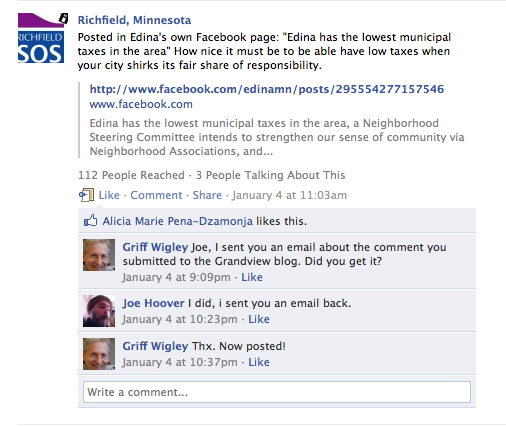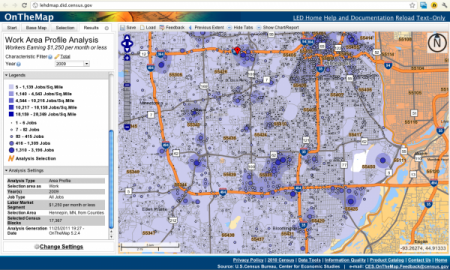 Based on the analysis of the City’s current supply of rental housing, there is an immediate need for rental housing at both ends of the affordability spectrum. On the one end would be upscale, amenity-rich properties that would appeal to young professionals and early retirees who currently must search outside the city for such options. On the other end of the spectrum would be subsidized units with two or more bedrooms for very low-income families, which are essentially non-existent in Richfield. ~Report Coverletter, Stantec Consulting Services
Based on the analysis of the City’s current supply of rental housing, there is an immediate need for rental housing at both ends of the affordability spectrum. On the one end would be upscale, amenity-rich properties that would appeal to young professionals and early retirees who currently must search outside the city for such options. On the other end of the spectrum would be subsidized units with two or more bedrooms for very low-income families, which are essentially non-existent in Richfield. ~Report Coverletter, Stantec Consulting Services
On April 16 of this year, Stantec presented their Richfield Housing Inventory and Needs Assessment at a Special Meeting of the HRA, Planning Commission and the City Council – I know that I wasn’t the only one in the audience who was surprised by the presentation but having a long background in data I knew that before I reacted I needed to look into the root data and see how the presenter arrived at his conclusions – the following is the first part of my assessment.
The most critical thing to keep in mind is that the report in its current form does not normalize the data which significantly complicates any meaningful interpretation. Also at question is their odd selection of “peer communities”. While a comparison of communities adjacent to (Bloomington, South Minneapolis, Edina) or nearby Richfield (Eden Prairie) is to be expected, the inclusion of the other suburbs is subjective and in this instance I’m deeply concerned that it implies correlations that are neither relevant nor appropriate.
Needs Assessment
I would like to point out that three different members of our city council stated very clearly at the onset that the scope of the project was to create an inventory of existing housing. Yet, the following areas were identified of potential need.
1. Two and Three-Bedroom Units
- Report: Therefore, in order for Richfield to diversify its supply of rental housing it should look for ways to increase the number of two-bedroom units either through new construction or perhaps rehabilitation of existing units.
- 2. Newer Properties with Modern Amenities and Features
- Report: This lack of newer rental options with modern amenities and features is limiting the City’s ability to retain longtime residents and attract new, younger residents who want more modern rental housing, particularly young professionals who work along I-494 or in Downtown Minneapolis.
- 3. Subsidized Units Appropriate for Families
- Report: To put the lack of subsidized housing into context, consider Richfield’s peer communities. Among the 11 communities analyzed, the overall percentage of general-occupancy rental housing that is subsidized is 6.4%. In Richfield, the percentage is less than 1%. Therefore, in order for Richfield to simply meet the peer community average, it would need to construct close to 300 new subsidized units.
- 4. Senior Housing (All Types)
- Report: The problem is that subsidized senior housing from this era was designed mostly for single women, which at the time made up the vast majority of need. Although older, single women still dominate the need for subsidized senior housing, there are many more low-income older couples today than there were 35 years ago.
In a previous blog post I gave my “2 cents needs assessment” to post against Stantec’s $24,000 needs assessment and am very proud to say that I was not very far off even if it was just on one of their four points.
My assessment:
….while Richfield has a good supply of affordable rental housing for efficiencies and units with 1 or 2 bedrooms, there is a critical gap in the supply of affordably-priced rental housing for units with three or more bedrooms.
I was pretty dead on.
I also said…
What probably won’t be discussed in the report is the appropriate thing to do
I was apparently dead on this prediction as well too.
So what is the solution?
My solution from my blog post is modified somewhat to fit Housing Report assessment that Richfield needs to build newer rental options with modern amenities and features and that the lack of such amenities is limiting the City’s ability to retain longtime residents and attract new, younger residents who want more modern rental housing, particularly young professionals.
- Convert many of the one bedroom units in older 1960s Class C apartment buildings that Stantec identified as needing renovation into subsidized three bedroom units to help the families in need of housing that can meet their income (Assessment 1) and also raise Richfield’s ratio of Subsidized Units appropriate for families (Assessment 3).
- Replace the lost market rate one bedroom units with newly constructed one bedroom units like those at Woodlake Plaza which would help attract higher income young professionals (Assessment 2) Include 10%-30% one bedroom subsidized units in those development for low wage young professionals seeking modern amenities and features.
What is NOT the solution? (and why)
Building new large scale, income-restricted apartment complexes with 2-3 bedrooms such as the proposed Pillsbury Commons; while it will make Ron Clark plenty of money to spend at the Galleria, using the Stantec data it is a poor decision for Richfield because, if we build new, large scale income restricted 2-3 bedroom rental housing, yes we will be filling the need but without removing older one bedroom units we will be adding to Richfield’s already massive affordable rental housing market NOT strengthening the tax base.
My Gap Analysis
There is still a gold mine of data with some interesting conclusions for anyone willing to take the time to slog through it.
Fun with data
Richfield Rental Housing Inventory report Table 17: Annual Household Income by Age of Householder and Tenure 2010
I found that by consolidating the base numbers and removing the non-peer peer communities an interesting trend appears (it is critical to note that I have not altered any data – what I’ve done is to remove areas of segmentation such as age).
| Annual Household Incomes of less than $10,000 |
| South Mpls |
1,478 |
| Bloomington |
1,360 |
| Richfield |
1,024 |
| Edina |
813 |
| Eden Prairie |
582 |
|
| Annual Household Incomes of less than $10,000 as % of Population Less than $10,000 |
| Richfield |
2.9% |
| South Mpls |
2.06% |
| Edina |
1.69% |
| Bloomington |
1.64% |
| Eden Prairie |
0.95% |
|
| Annual Household Income of $150,000 or more |
| Edina |
5,241 |
| Eden Prairie |
5,610 |
| Bloomington |
3,476 |
| South Mpls |
5,080 |
| Richfield |
710 |
|
| Annual Household Income of $150,000 or more as % of Population |
| Edina |
10.93% |
| Eden Prairie |
9.23% |
| South Mpls |
7.09% |
| Bloomington |
4.19% |
| Richfield |
2.02% |
Conclusion: Richfield is not only the top city with Annual Household Incomes of less than $10,000 as percent its of population AND the bottom city with Annual Household Income of $150,000 or more as a percent of its population but we are the only city that has a greater percentage of its population with household incomes of less than $10,000 than household incomes of $150,000 or more. So which is more important? If our goal is economic diversity and sustainable, supportable and responsible growth, is it more important for Richfield to increase its percentage households of incomes of less than $10,000 or does it need to increase its percentage of households with incomes of $150,000?
Misleading Data
Also if you inspect the data you do find that it may not represent the real situation. For example take the following finding in the report:
Richfield has very few subsidized units; less than 1% of its general occupancy (non-senior) rental stock is subsidized. In contrast, its peer communities have an average of 6.4% of their rental stock as subsidized units.
Yet we need to consider the fact that in Edina, one of their subsidized developments Yorkdale Townhomes with 90 units was built on Richfield’s border and within the Richfield School district.
So the report lists Edina having 154 subsidized units making 3.2% of Edina’s rental housing stock as subsidized is misleading because it does not fully impact the infrastructure of Edina. If you subtract the 90 units that were built in Richfield’s School district Edina would actually have 64 units making 1.3% of Edina’s rental housing stock subsidized.
Richfield in contrast would actually have 131 units if you added the subsidized rental housing built within its school district boundaries making for an actual 2.7% of rental units that are subsidized. Still not quite 6.4% but I strongly suspect that upon investigation many of the subsidized numbers would not hold up similarly as Edina’s didn’t.
Additionally, even if you think it is a stretch to consider Yorkdale Townhomes in Richfield’s subsidized housing numbers it is still important to point out that Edina has 4,803 rental units, Richfield 4,857 – based on population that means that Richfield has one rental unit per 6.85 people and Edina has one unit per 9.69 people – that’s about a 45% difference.
Next …
This is not the end of my analysis of the Richfield Housing Inventory Report. I also completely left out Needs Assessment, Senior housing which I think is very important and does have and should have a very important place in Richfield’s rental housing plans. Unfortunately, I have to volunteer my time to crunch numbers so I can only squeak out my analysis and assessments as time allows. But guaranteed I will be posting on this subject more to this blog and the Facebook page.
 Lack of transparency and user friendliness at the City of Richfield once again rear their ugly heads with the most recent submission of Ron Clark Construction’s proposal to the City. At the May 8th council meeting Council member Fred Wroge brought up the issue that he had found that the Richfield Patch had posted all of the documents Ron Clark had submitted for Pillsbury Commons before he had received them from the city. Steve Devich corrected him saying that the documents were posted on the City’s web site and that Patch must have downloaded them from there.
Lack of transparency and user friendliness at the City of Richfield once again rear their ugly heads with the most recent submission of Ron Clark Construction’s proposal to the City. At the May 8th council meeting Council member Fred Wroge brought up the issue that he had found that the Richfield Patch had posted all of the documents Ron Clark had submitted for Pillsbury Commons before he had received them from the city. Steve Devich corrected him saying that the documents were posted on the City’s web site and that Patch must have downloaded them from there. Based on the analysis of the City’s current supply of rental housing, there is an immediate need for rental housing at both ends of the affordability spectrum. On the one end would be upscale, amenity-rich properties that would appeal to young professionals and early retirees who currently must search outside the city for such options. On the other end of the spectrum would be subsidized units with two or more bedrooms for very low-income families, which are essentially non-existent in Richfield. ~Report Coverletter, Stantec Consulting Services
Based on the analysis of the City’s current supply of rental housing, there is an immediate need for rental housing at both ends of the affordability spectrum. On the one end would be upscale, amenity-rich properties that would appeal to young professionals and early retirees who currently must search outside the city for such options. On the other end of the spectrum would be subsidized units with two or more bedrooms for very low-income families, which are essentially non-existent in Richfield. ~Report Coverletter, Stantec Consulting Services







 The City of Richfield has just hired
The City of Richfield has just hired 